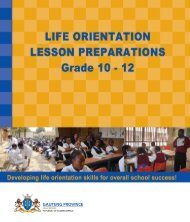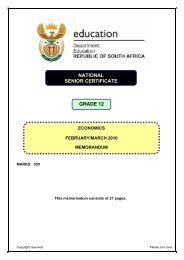Life Science Grade 11
Life Science Grade 11
Life Science Grade 11
Create successful ePaper yourself
Turn your PDF publications into a flip-book with our unique Google optimized e-Paper software.
<strong>Grade</strong> <strong>11</strong> <strong>Life</strong> <strong>Science</strong>s Lesson Plans• The Plasmodium needs the Anopheles mosquito as a vector.• Have learners write down the following in their notebook:• Malaria kills millions of people throughout the world• Symptoms of the disease include flu-like symptoms of chills, high fever,shivering and sweating, headaches and vomiting up to two weeks afterbeing bitten by the infected mosquito• In severe cases, convulsions can occur and if the liver and spleen areinfected the person becomes jaundiced• As red blood cells rupture the person becomes anaemic• The infected red blood cells can cause blockages in the blood vessels ofmajor organs and eventually cause death• Treatment for malaria includes using drugs such as chloroquine tointerrupt the parasite’s life cycle• A traditional malaria remedy involves using the herb sweet wormwoodwhich grows mainly in the mountains of South East Asia• Managing the disease includes vector control programmes personalprotection measures such as insect repellents and the use ofpreventative medicines such as quinine• Another disease caused by a micro-organism is caused by a fungus• Athlete’s foot produces a red rash between the toes• Fine filamentous fungi invade the skin if the environment is moist andwarm such as between the toes• Sometimes the skin may crack and bleed if untreated and the rash mayspread to the soles of the feet or the palms of the hand• Athlete’s food may be treated with anti-fungal creams• Wearing shoes that allow the skin to breathe (leather shoes) and thickcotton socks helps keep the skin drier and cooler so that the fungus willnot grow• Learners should complete a table that lists the four types of microorganisms,the effects of each disease they cause and the managementof these diseases10 min5 min2.3 Conclusion• Learners should be aware that although many micro-organisms arebeneficial in ecosystems , there are many that are pathogenic• Re-emphasise diseases that each group of micro – organisms may causeTerm 1 Page 15© Gauteng Department of Education (CAPS version)







